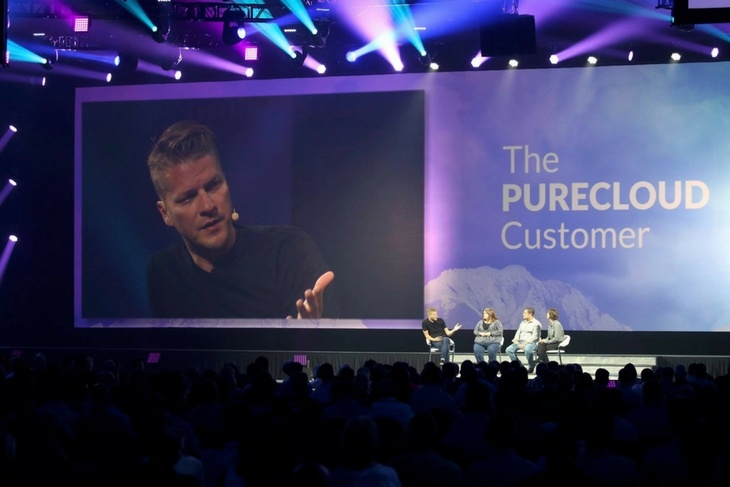Liquid expectations and microservices drive culture of innovation at Interactive Intelligence
Interactive Intelligence founder Don Brown is unassuming and fairly soft-spoken for an entrepreneur, except when you get him talking about technology — particularly those innovations developed by the company he founded that recently entered into a merger agreement to be acquired by Genesys for $1.4 billion. He often refers to the company’s customer engagement solutions as “badass”, and he doesn’t shy away, even with media and analysts, from bold statements about Interactive’s fast-selling PureCloud platform.
“We’re doing some really cool work with wild stuff like virtual reality in customer service settings, machine learning for outcome optimization, and customer journey mapping,” Brown said on a call with analysts earlier this summer. “So we intend to go way, way beyond just the basic sort of contact center stuff that we’ve done today that’s already putting fear in the hearts of our competitors.”

That bold brand of leadership and the technologies it has inspired recently earned the company recognition as a leader in the Gartner Magic Quadrant for Contact Center Infrastructure for the eighth time.
But the last few years have not been without struggles. The company took a big risk to build from scratch a totally new cloud solution, PureCloud, to keep it and its customers from being disrupted. Brown says he and the board knew they would take a hit financially, but that it was the right thing to do strategically to ensure long-term technological relevance and business stability.
(EDITOR’S NOTE: According to Paul Segre, CEO of Genesys, which announced it was acquiring Interactive Intelligence on August 31, Genesys plans to significantly invest in PureCloud and other software products. Keep reading to learn more.)
The Liquid Expectations of Consumers
PureCloud, which runs on Amazon Web Services (AWS), is selling fast in a market that is notoriously resistant to change due to the associated costs, retraining of customer service personnel, and general “stickiness” of legacy web-based and on-premises software.
“We continue to see rapid adoption of cloud solutions in the customer engagement space all the way up to the high end and across all verticals and geographies,” Brown said. “We are hitting this inflection point at the perfect time with the best solution on the market.”

The inflection point Brown is talking about is being driven by consumers’ liquid expectations and the need for companies (Interactive Intelligence’s customers) to exceed not just the performance of their competition, but to match the service quality of innovators like Amazon, Apple, Zappos and other brands known for their superior customer service.
Dan Rood, senior director of content and product marketing for Interactive Intelligence, explained in a presentation that “the notion of liquid expectations is that customers are starting to judge an industry’s customer service based on the experience they are having in a different industry, which is kind of new.”
“For example, customers are beginning to judge an airline’s ticket return policy based on the experiences they have when returning shoes to Zappos, and so what’s happening is that customers are starting to expect more and more,” Rood said.
Meeting Demand Through Microservices
This is where the cloud and Interactive Intelligence’s innovative microservices approach offers the company and its customers a serious advantage. No matter what precautions are taken, things are going to fail — the power will go down or something unforeseen will happen. In the traditional call center architecture, which is more monolithic and built like a building from the ground up, something breaking can cause disruption and bring an entire operation to a halt.
With a microservices approach, however, the software architecture and its various applications are independent of one another and only loosely coupled, so that if an automatic call distributor (ACD) or interactive voice response (IVR) function goes down, or chat or social engagement fails, it has a negligible impact on the overall customer service operation.

When Interactive Intelligence first launched PureCloud it thought it would have to spend a lot of time defending and selling the idea of running the software on AWS. While that may have been of some concern early on, today it’s a non-issue with behemoths such as Netflix running their cloud operations on AWS.
“The conversation [with customers] has pivoted to how you architect within the cloud,” Rood said. “You see, a lot of vendors are taking their monolithic architecture and putting it into a multitenant cloud. It may be in the cloud, but it’s not true cloud architecture because it’s still governed by the limitations of client-server solutions: long deployment times, reliability issues, long release cycles, and so on.

By leveraging everything AWS has to offer using a microservices approach, Interactive Intelligence is able to create new features much more quickly. Rood described it as an elastic environment that can scale up or down as needed. And when it fails, it fails gracefully — meaning the customer rarely has to experience the failure because it only affects one feature rather than the entire platform.
The velocity of new features delivered by PureCloud has also benefitted Interactive Intelligence’s long-standing CIC on-premises solution.
“For a long time to come, there will be customers who require on-premises customer engagement solutions,” Rood said. “We’re building integrations so those customers can also take advantage of certain PureCloud features. With integrations between CIC and PureCloud– not to mention our private cloud solution, CaaS — customers get incredible flexibility. That means long-term investment protection even as business models change.”
The Impact of Acquisition
Many have wondered how the recent announcement about Genesys acquiring Interactive Intelligence would impact both companies’ product roadmaps.
In an excerpt from a statement made by Genesys CEO Paul Segre, he says, “Our combined product portfolio will provide the broadest set of transformative customer experience solutions optimized for customers of all sizes and sophistication levels, available both in the cloud and on-premise.
“We will significantly invest across the entire Interactive Intelligence product portfolio to support the continued momentum of PureCloud®, Cloud Communications-as-a-Service℠ (CaaS) and Customer Interaction Center™ (CIC), in addition to the rich portfolio of products offered by Genesys today. We are excited to work with the Interactive Intelligence team to deliver even greater innovation and value to our global customers and partners.”


